What to do if a gas boiler is blown out by the wind: causes of boiler extinguishing and methods for eliminating the problem
An autonomous heating system ensures a comfortable indoor environment.When it fails, the established order and comfort are disrupted. Agree, no one wants to be left in the winter with a constantly dying heating boiler. And if the gas boiler is blown out by the wind, what should the owner do in such a situation?
We will help you deal with this problem - the article discusses the reasons for the boiler to fade and methods for solving this problem. Visual photographs and video materials are provided.
The content of the article:
Reasons why the burner flame goes out
Boiler damping due to wind is not such a rare problem. This concerns apartment owners less often - 95% of the equipment has a coaxial air duct. But home owners often encounter burner extinguishing. Let's try to find the source of the problem and restore the device to functionality.
So, the boiler may go out due to inconsistencies in the technical parameters of the chimney and operating conditions. Another factor - wrong ventilation arrangement. It is wise to entrust the elimination of such faults to specialists.
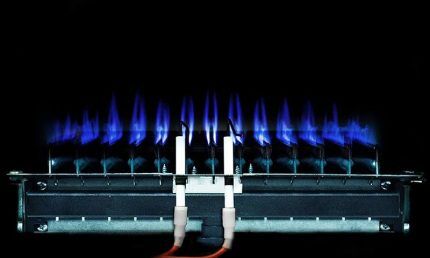
A situation often arises when the air mass acting outside creates pressure and the check valve is triggered. A strong gust of wind returns it to the closed position, and the gas supply to the firebox stops. In this case, reconstruction of the chimney is necessary.
Boiler damping may be due to:
- Breakdown flame control sensor. A worn thermocouple or ionization electrode knocks out the automation after the slightest breath of wind. The solution is to replace the faulty part.
- Weak burning of the wick due to the fact that it is clogged or there is insufficient pressure at the inlet. If there is a regulator, you need to check its settings and increase the pressure. Plus clean the wick.
- Poor traction in the chimney.
- Availability of the system for wind - no protection. Applies to single-story buildings and the upper floors of high-rise buildings. The problem is solved by installing a weather vane deflector.
- Incorrect chimney design - when there are not enough turns. If it comes out of the boiler directly into the wall, the wind easily enters the boiler. But you cannot make more than three turns on the outlet pipe.
- Incorrect ventilation system or lack of channels.
- Malfunction of safety sensors — traction sensor, limit thermostat. It is necessary to check the contacts of the protective equipment and clean them.
- The location of the chimney in the zone of wind pressure.
Why else can a gas boiler go out in the wind? Sometimes the equipment is located in a kitchen with a balcony on the second or third floor of the building. It is enough to open the balcony door for a strong draft to suddenly form, the wick begins to vibrate and goes out.
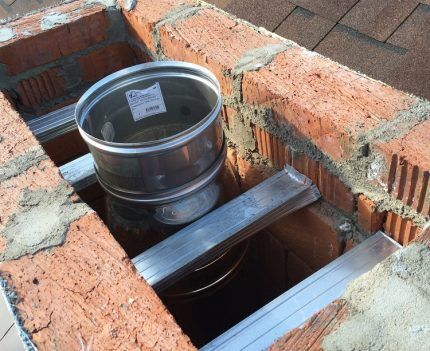
It is useful to inspect the external elements of the heating system for the presence of ice buildup.
There's no point in knocking him down. It is necessary to turn off the gas, bring the removable parts into the room for slow thawing. After returning them to their place, warm up the device, gradually increasing the gas pressure.
Ways to solve the issue of boiler attenuation
The option for restoring the functionality of gas equipment depends on the cause of the extinction. Next, we will figure out what can be done to prevent the boiler from fading in the wind.
#1 - Fighting Bad Cravings
Draft is an external force in the chimney that causes combustion products to rise and escape into the atmosphere, exchanging places with fresh air. This occurs due to the higher density of cold air compared to the density of warm combustion products.
In the context of the boiler damping problem, the draft can be:
- Insufficient, which leads to the sensor triggering and the burner to go out.
- Excessive - formed when there is an excess of ventilation ducts or an incorrect position of the chimney. In this case, the speed of combustion products increases and the boiler goes out.
- Reverse, due to which the flow of combustion products changes direction and returns to the furnace. Not only is the flame fading, but also gas pollution in the premises.
The sources of trouble are hidden in the design flaws of the chimney or current malfunctions. Particular attention should be paid to the location of the pipe - its upper part should rise at least half a meter from the extreme point of the roof.
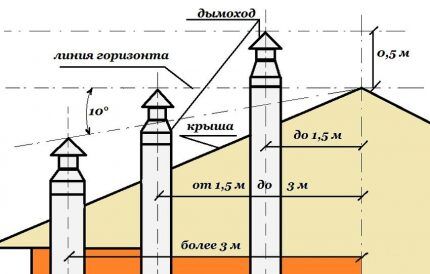
It is necessary to check the tightness of the connections, the serviceability of the fan, the presence of foreign objects, debris, and a large layer of carbon deposits in the pipe and eliminate the defects. Current faults also include damage to the thermal insulation - the chimney must be warm.
No. 2 - installation of a weather vane deflector
The current method for boiler damping due to wind is installation on the chimney deflector. The aerodynamic device can be of different configurations.
In a conventional weather vane, air flows are directed to the outer part. Their interaction with the deflector surface creates a rarefied atmosphere, which increases thrust.
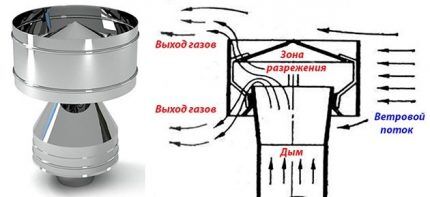
A simple weather vane increases the efficiency of any pipe by 15-20%. But it is not able to completely solve the problem of the boiler dying out. It is more profitable to use a device of complex configuration.
Suitable designs:
- Grigorovich;
- Wolpert;
- spherical, rotating;
- other.
IN Grigorovich deflector all elements are subject to the laws of aerodynamics. The device is double-cone. The interaction of the forward and reverse cones distributes the passing air flows so that a zone of reduced pressure is formed around the pipe.

Wolpert deflector It is a structure of two “glasses” - cylindrical and with a downward expansion. The top one with the lid fits somewhat onto the bottom one.
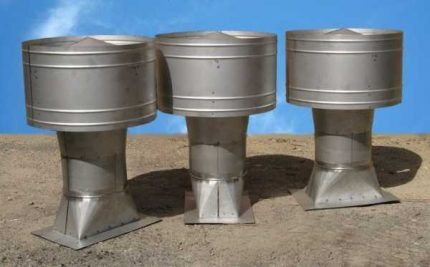
There is also a combined device - Volpert-Grigorovich deflector. It has a reverse cone, a curved diffuser surface and an umbrella cover.The design shows good effectiveness in solving the problem of boiler decay and increases its efficiency by 25%.
We have provided the requirements for the deflector for the chimney of a gas boiler and installation instructions in next article.
Any deflector requires regular maintenance - cleaning and lubrication, otherwise the opposite effect will occur. It is not recommended to install umbrella canopies - they violate safety regulations.
No. 3 - gradual heating of the boiler
If the heating system has been turned off for a long time, the wind may blow out the gas boiler due to insufficiently heated chimney. This situation is typical for country houses, when after the first start-up of the equipment the burner quickly goes out.
The explanation for the phenomenon is simple: it is difficult for waste combustion products to rise up a cold pipe, and gusts of wind interfere with the heating of the channel.
You need to act like this: start the system at low speeds and gradually increase the power of the device to optimal levels. This will create natural conditions for the release of hot combustion products.
Solving the problem for different types of boilers
Equipment with a closed burner is called turbocharged and it requires electricity to function. To prevent damage to the control board during power failures, when installing boilers, install Voltage regulator.
Boiler units with an open combustion chamber are called atmospheric. They are independent of the power supply system.
So, atmospheric and turbocharged boilers have different devices. Therefore, the principles for solving the problem of their attenuation will also differ.
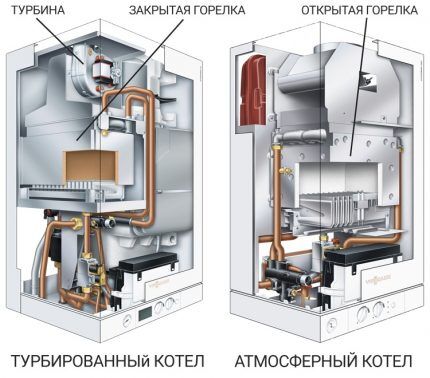
IN atmospheric boilers the craving is natural. The device does not receive the set volume of air if it is insufficient or there is insufficient air flow. It is necessary to artificially increase the volume of oxygen taken in by installing additional supply ventilation and a regular hole in the door with a grill.
You can also use one of the following methods:
- reducing the diameter of the chimney by installing an internal pipe, which will speed up heating and eliminate the effect of excessive dilution of gas with air;
- installation of a deflector;
- increasing the length of the chimney.
Turbocharged boilers more stable in operation, but subject to their installation on the leeward side.
In the opposite situation, installing a deflector or reconstructing the chimney by creating a system in it will help "break of traction" - construction of a zone inside the chimney that prevents the reverse movement of combustion products.
Conclusions and useful video on the topic
Installation of a wind barrier.
How to make a protective cover for a parapet boiler.
What is useful to know before installing and operating a weather vane deflector.
The efficiency of a heating system depends on competent thermal calculations when designing a house, proper operation and regular maintenance. Having examined the reasons why a gas floor-standing or wall-mounted boiler blows out in the wind, we can summarize: the problem can be eliminated by replacing (repairing) individual parts, checking or re-equipping the entire chimney structure.
Measures to restore the functionality of equipment should be entrusted to specialists.If you do this yourself, you should definitely consult with experienced professionals..
Would you like to tell us about your experience in solving the problem of boiler damping in the wind? Write your recommendations in the comments block.
If you still have questions about the topic of the article that we have not touched upon in this publication, ask our experts. The feedback form is located below.




Good afternoon, I don’t know where to start. I have a Danko 10 boiler, it worked for a year or even two without problems, this season the problems started, it started to go out every 7-9 hours (whenever), I tried everything I could, I replaced almost everything except the automatic equipment with a thermal cylinder, I checked everything, but the problem is that I can’t understand it a little, the technicians from the gas service don’t give good advice, then look at this, etc. After watching a lot of videos, I realized that I don’t understand shit. I’ll be grateful for any help. With respect from Kazakhstan .